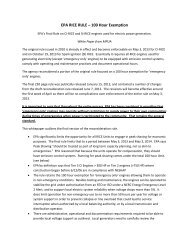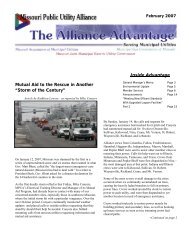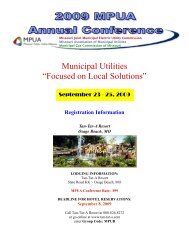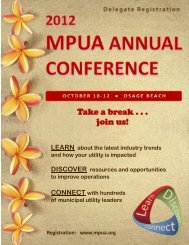November 2009 - MPUA Missouri Public Utility Alliance
November 2009 - MPUA Missouri Public Utility Alliance
November 2009 - MPUA Missouri Public Utility Alliance
Create successful ePaper yourself
Turn your PDF publications into a flip-book with our unique Google optimized e-Paper software.
NOVEMBER, <strong>2009</strong><br />
<strong>Missouri</strong> Association of<br />
Municipal Utilities<br />
<strong>Missouri</strong> Joint Municipal<br />
Electric <strong>Utility</strong> Commission<br />
Municipal Gas Commission<br />
of <strong>Missouri</strong><br />
CITY OF FULTON<br />
AWARDED “SMART GRID”<br />
STIMULUS FUNDS<br />
Trisha Barnes<br />
Executive Assistant<br />
tbarnes@mpua.org<br />
Inside this issue:<br />
General Manager’s Memo<br />
2<br />
Member Relations News 4<br />
Plain Talk 5<br />
Legislative Report 7<br />
Environmental Update 9<br />
Regulatory Law News 14<br />
Renewable Energy Efforts 15<br />
APPA Washington Report 18<br />
S elected from over 400 applicants, the City of Fulton’s municipal electric utility is one<br />
of 100 recipients of Smart Grid Grant awards just announced by the Department of Energy.<br />
Those projects, which include more than 30 projects sponsored by municipally-owned<br />
utilities, will receive stimulus funding under the Smart Grid Investment Grant program.<br />
Fulton is the only <strong>Missouri</strong> recipient of these monies – public or private.<br />
The City of Fulton’s project will replace more than 5,000 current electric meters with a<br />
smart meter network that includes a dynamic pricing program to reduce consumer energy<br />
use. Fulton’s share of the grant awards is just over $1.5 million which was matched by the<br />
city. The city also made an additional commitment of $1 million for gas and water meter<br />
improvements. The project is expected to take 18 months to implement once the final<br />
award is received.<br />
. . . continued on page 10<br />
<strong>MPUA</strong> Mutual Aid<br />
Network<br />
Highlighted at PSC<br />
Workshop<br />
Ewell Lawson<br />
Government Relations & Member and Finance Services<br />
elawson@mpua.org<br />
O n October 19, <strong>2009</strong>, Mike Conyers, <strong>MPUA</strong>’s Mutual Aid Coordinator and Director of<br />
Lineworker Safety and Training, addressed a <strong>Public</strong> Service Commission Workshop on<br />
storm restoration efforts and best practices in storm preparation and power restoration. The<br />
<strong>Missouri</strong> State Emergency Management Agency (SEMA) also participated in sponsoring<br />
the Workshop.<br />
The workshop included storm-specific reports from the state’s investor-owned utilities,<br />
which are regulated by the PSC, as well as the responses of locally-regulated municipals<br />
and cooperatives. The agenda focused on lessons learned and included reports on storm<br />
events over the last few years, response improvements during these storms, SEMA and<br />
state agency needs, communication coordination by utilities, and best practices.<br />
. . . Continued on page 8<br />
. . . continued on page 6
GENERAL MANAGER’S<br />
MEMO<br />
Duncan Kincheloe<br />
General Manager & CEO<br />
dkincheloe@mpua.org<br />
MAKE TIME FOR THE<br />
DAY AFTER TOMORROW<br />
W e had a fantastic, energizing <strong>MPUA</strong> Annual Conference<br />
several weeks ago. The <strong>MPUA</strong> staff returned to the office<br />
eager to move ahead with planning the details of exciting new<br />
service arrangements the Boards had adopted in next year’s<br />
The biggest differences we can make in cost and service<br />
usually come from action we take long before customers are<br />
even aware the issue exists.<br />
budgets. We’re going to be able to make 2010 a great year for<br />
high-impact member service. I hope every municipal utility<br />
will give time and attention to getting the most from these<br />
services for its operations, personnel and customers.<br />
As in offices everywhere, the time and attention required to<br />
plan next year’s work here has to compete with the demands of<br />
our daily operational requirements and the ordinary surprises<br />
each new week delivers. We all take that for granted wherever<br />
we work. In looking at the past month’s calendar I was struck,<br />
however, by the time also required to give adequate attention to<br />
years beyond 2010 -- and to contingencies that may never really<br />
occur at all, especially if we prepare for them. The biggest<br />
differences we can make in cost and service usually come from<br />
action we take long before customers are even aware the issue<br />
exists. But confronting major issues that shape the future<br />
doesn’t fit easily with concentrating on immediate daily<br />
demands, especially when today’s inbox looks interesting as<br />
well as insistent.<br />
So during several days in October, even though we all had calls<br />
to return and wanted to get on with developing our programs<br />
for 2010, Phil Walsack and other senior staff instead felt it<br />
necessary to meet with Director Mark Templeton and DNR<br />
officials about the outlook on enforcement and potential EPA<br />
activity during the next several years. Mike Conyers also<br />
participated in <strong>Public</strong> Service Commission deliberations on<br />
storm readiness/recovery and inter-utility planning that may not<br />
bear fruit for many years. I participated in a Washington strategy<br />
session on climate change legislation and a workshop and<br />
meeting on electric transmission, FERC policy and other legal<br />
issues. Other staff, as always, worked with members on new<br />
contracts, facilities, or financing involving supplies or<br />
construction that is three, five or ten years down the road.<br />
None of this excused us from taking care of the immediate needs<br />
of the month, and our 2010 programs will roll out on schedule,<br />
but opportunities to shape or prepare for the longer term future<br />
can’t be neglected just because no constituency appreciates them<br />
immediately. I’m not making this point to crow or carp about the<br />
<strong>MPUA</strong> staff workload. I think you already know they work hard<br />
for you. I’m emphasizing the importance of attending to long<br />
term needs because I want to underscore the value of your<br />
participation in <strong>MPUA</strong> programs, especially those being<br />
introduced next year. You’ll find that many of them represent<br />
your best opportunities to manage<br />
and prepare for challenges that hit<br />
hard in communities that fail to act<br />
wisely and early.<br />
Taking advantage of <strong>MPUA</strong><br />
services may cost a day away from<br />
your desk or worksite, or an<br />
interruption of your local routine by<br />
an <strong>MPUA</strong> team or representative.<br />
And whether we’re talking about<br />
technology, personnel training, financial or facility planning,<br />
environmental compliance, reducing utility costs, improving<br />
customer communications or other topics, the payoff may take<br />
several years to become visible. It’s tempting to tell ourselves we<br />
need to apply every bit of available time and attention to solving<br />
the problems that every day serves up. But as we think about the<br />
most serious of those problems, how many could have been<br />
avoided or substantially alleviated by greater attention or<br />
expertise applied several years ago<br />
So as you hear announcement of programs and organizational<br />
meetings in the weeks ahead, I hope you’ll remember that these<br />
services represent some of your best opportunities to manage the<br />
future and avoid potential headaches of the next decade. Early<br />
confrontation of major issues interferes with our daily routines,<br />
ordinary comfort zones, and usual daily surroundings, but we fool<br />
ourselves whenever we think we’ve satisfied our responsibilities<br />
merely by first-rate handling of whatever lands in today’s inbox.<br />
The best opportunity – often the only real opportunity – to affect<br />
the largest issues, risks and costs exists only in attacking them<br />
long before they reach our desks and communities.<br />
There will be an opportunity to affect the future by being in<br />
Columbia for the Board meetings on December 10 th when we’ll<br />
talk more about <strong>MPUA</strong> services being structured to help with<br />
some of the storm clouds on the horizon. Hope to see you then!■<br />
2
GUEST COLUMN<br />
<strong>Missouri</strong>’s Underground<br />
Damage Prevention<br />
Program<br />
By: Robert M. Clayton III<br />
Chairman, MO <strong>Public</strong> Service Commission<br />
T he <strong>Missouri</strong> <strong>Public</strong> Service Commission values the solid<br />
working relationship we have enjoyed with <strong>Missouri</strong>’s locallyregulated<br />
municipal utilities. Both municipals and investorowned<br />
utilities face similar challenges whether responding to<br />
devastating weather or addressing developing issues associated<br />
with regional transmission organizations. Recently, municipal<br />
utilities have graciously accepted our invitation to participate in<br />
recent PSC workshops on climate change, storm restoration and<br />
on planning efforts for the future.<br />
The PSC is hoping to open a dialogue with stakeholders and ask<br />
for assistance in addressing a state-wide concern. Congress<br />
passed the Pipeline Inspection, Protection, Enforcement and<br />
Safety (PIPES) Act of 2006, suggesting the need to improve<br />
state-wide damage prevention programs. The Act prescribed<br />
nine program elements that reflect processes and attributes<br />
characteristic of comprehensive and effective damage<br />
prevention. Investor-owned utilities annually suffer on average<br />
from over 10,000 separate incidents of damage to their<br />
infrastructure caused by third parties at significant cost. As<br />
you are aware, any costs that go unreimbursed eventually are<br />
passed on to the rate paying customer.<br />
In light of this unnecessary damage, I directed our staff to<br />
compile a legislative proposal to reevaluate how third-party line<br />
cuts are addressed. The proposal was submitted to all interested<br />
stakeholders. The PSC hopes to learn the extent of the problem,<br />
if any, beyond the perspective of the PSC-regulated entity, and<br />
attempt to find a solution, if necessary, to the significant impact<br />
of third-party damage to infrastructure.<br />
The proposal outlines the creation of an advisory group made<br />
up of utilities, excavators and regulators that will evaluate<br />
reported cuts in infrastructure around the state, regardless of<br />
whether the entity is subject to regulation at the state or local<br />
level. The advisory committee would make a recommendation<br />
on how to proceed including a strong education component, but<br />
also leaving an opportunity for ordering full reimbursement to<br />
the utility as well as potential penalties for any repeat or<br />
egregious wrongdoer.<br />
Today, utilities must seek recourse through various courts or by<br />
referral to the Attorney General with action in the circuit court.<br />
Neither remedy provides a timely or cost-effective method of<br />
dispute resolution. We are suggesting a possible joint<br />
jurisdictional concept of allowing for the resolution of these<br />
disputes before the <strong>Missouri</strong> <strong>Public</strong> Service Commission with<br />
enforcement by either the PSC or by the AG. We have a<br />
knowledgeable staff and the PSC is well versed in utility issues.<br />
The proposal does not suggest jurisdiction over any locallyregulated<br />
utility but rather offers a forum for all utilities to resolve<br />
these disputes against third-parties.<br />
On October 21 st , the PSC held a workshop inviting all<br />
stakeholders including excavators (heavy contractors, utility<br />
excavators, small contractors and individual homeowners),<br />
locators, operators of underground facilities (pipelines, electric,<br />
water, sewer, telecommunications, cable, municipally-owned,<br />
investor-owned), the One-Call Center, emergency responders,<br />
MoDOT, railroads, local governments, and the general public.<br />
It is my hope that a comprehensive damage prevention program<br />
that includes effective, fair, and timely enforcement of all the<br />
provisions of the damage prevention statute can lower the risk of<br />
excavation damage, which has effectively reduced incidents in<br />
states such as Virginia and Georgia.<br />
The PSC looks forward to working with you in finding solutions<br />
to these issues in a collaborative and constructive effort. You can<br />
access the entire record about the proposal on our website at<br />
www.psc.mo.gov and click on Under ground Facility Damage<br />
Prevention Project. My office is always open to you if you have<br />
any questions or concerns.■<br />
Joe F. Russell<br />
Municipal Power Sales Representative<br />
russeljf@oge.com<br />
PO Box 321, M/C GB58<br />
Oklahoma City, OK<br />
73101<br />
Phone: 405/553-2766<br />
Fax: 405/553-2115<br />
Complete SCADA Systems<br />
Distributed and Conventional RTUs<br />
Substation and Distribution Automation<br />
System Integration and Engineering<br />
Fiber Optic Installation and Testing<br />
3
MEMBER RELATIONS<br />
NEWS<br />
Floyd Gilzow, Director<br />
Member Relations & <strong>Public</strong> Affairs<br />
fgilzow@mpua.org<br />
Don’t Blink or You May Miss<br />
$12.5 Million<br />
DNR grant program on high speed schedule<br />
A new DNR grant program focused on cities with populations of<br />
less than 35,000 or counties of less than 200,000 isn’t even designed<br />
yet, but the deadline for application is before Christmas <strong>2009</strong> and<br />
money will be available in March 2010. The program is funded<br />
through the Federal Stimulus appropriation.<br />
While ―Energize <strong>Missouri</strong> Communities‖ is styled as an energy<br />
program, it will have a significant focus on Water and Wastewater<br />
according to William Haas, a DNR contractor with Shaw<br />
Environmental. Haas, other Shaw Environmental staff, and DNR<br />
Energy Center staff were holding a series of 6 workshops the middle<br />
two weeks of October across the state to solicit input on the design of<br />
the grant program.<br />
It appears that the grants will be limited to one of five specific areas:<br />
Water and Wastewater System Energy Efficiency<br />
Landfill Gas to Energy Projects<br />
Exterior and Interior Lighting Retrofit<br />
Green Streets<br />
Special Projects<br />
Water and Wastewater projects could include upgrades to pumps and<br />
installation of variable speed motors. Designers say they are also<br />
considering covering engineering studies to determine the location of<br />
water losses in municipal systems and system rehabilitation since<br />
improving system integrity would reduce municipal electric power<br />
consumption. After discussions with <strong>MPUA</strong>, designers said they<br />
would also consider sewer integrity studies and rehabilitation since<br />
inflow and infiltration have similar impacts on energy usage.<br />
Because the program is still in design, a number of grant details<br />
have not been finalized. No decision has been made on whether<br />
a local match will be required and whether it would be in cash,<br />
in-kind or some combination of both. According to Haas, a local<br />
match is almost certain, but because of the financial challenges<br />
many local governments are facing, it was not likely that a large<br />
cash match would be required.<br />
Grant funds cannot be used for projects which are currently<br />
under construction, or have been completed. However a system<br />
under design would be eligible, as would the expansion of a<br />
current project in order to improve energy efficiency. For<br />
instance, a municipal drinking water plant under construction<br />
could receive a new grant to install more energy efficient pumps<br />
that were not affordable during the initial design.<br />
Applications will be competitively ranked on a variety of criteria<br />
including the amount of energy saved, the cost effectiveness of<br />
the project, the number of partnerships in the project, the volume<br />
of green house gas reduced, the strength of project management,<br />
persistence of the project after funding terminates, and<br />
leveraging monies borrowed from <strong>MPUA</strong>’s finance program.<br />
Leveraged money could also include grants from foundations<br />
and local businesses or other state or federal grants. DNR will<br />
be hosting another series of workshops later in <strong>November</strong> after<br />
the program has been designed to assist in the application<br />
process.<br />
Under federal law, 60% of the $12.5 million is reserved for the<br />
smaller cities and counties. The remaining 40% is available to<br />
all <strong>Missouri</strong> cities and counties, including those areas that<br />
received formula grants under the Energy Efficiency and<br />
Conservation Block Grant earlier this year. An estimated 1,500<br />
cities and counties in <strong>Missouri</strong> are eligible to apply. Grant<br />
designers anticipate that an average sized project will be about<br />
$500,000.<br />
<strong>MPUA</strong> staff will continue to monitor the work of the Energy<br />
Center as this grant program is designed and will make materials<br />
available as they are released. We are also available to answer<br />
questions and assist in developing partnerships among<br />
communities on specific projects. Contact <strong>MPUA</strong> at 573-445-<br />
3279 if we can help answer any questions. Materials will be<br />
made available on-line by the State at http://dnr.mo.gov/<br />
transform/energizemissouri.htm.■<br />
Landfill Gas to Energy grants could incentivize projects that include<br />
collection, processing, and energy production systems where the city<br />
either owns the landfill or receives the benefits of the energy coming<br />
from the landfill.<br />
Green Streets grants could be an effort to address planning and<br />
energy efficiency issues in the downtown business districts of<br />
<strong>Missouri</strong> communities with a goal of reducing the environmental<br />
impact of these areas.<br />
4
Plain Talk<br />
Phil Walsack<br />
Mgr. of Environmental Services<br />
pwalsack@mpua.org<br />
Just How Bad IS Our System<br />
L ooking at <strong>Missouri</strong>’s newspapers and TV news reports over<br />
the past two months you can see that public interest in sanitary<br />
sewer systems has been aroused. Sewer rates in several<br />
communities are on the rise. Reports of failing infrastructure are<br />
making headlines. The publicity gives credence to the<br />
importance of sewer infrastructure. It may also lead City<br />
Councils to pepper their managers and consultants with questions<br />
like ―How bad is our system‖ ―How much inflow and<br />
infiltration (I/I) do we have‖ What are we doing to make our<br />
collection system tighter and keep excess water out‖ [for a<br />
refresher on I/I, see the Plain Talk article in the February ’09<br />
<strong>Alliance</strong> Advantage]<br />
Once these data sources have been researched and correlations<br />
found, the municipality must establish sewer flow monitoring<br />
points at various locations within the collection system.<br />
Collection systems must be broken down into sewersheds or<br />
basins.<br />
Flow monitoring instrumentation must be placed in sanitary<br />
sewer systems at locations appropriate to gather meaningful<br />
data. There are many types of flow monitoring instruments<br />
available and pricing varies accordingly. A tape measure,<br />
notebook, and digital camera is surprisingly effective if you have<br />
. . . Continued on page 17<br />
Nationwide, I/I is a difficult problem to solve because there are<br />
about 4.0 billion feet of sanitary sewer collection mains. If these<br />
mains were laid end-to-end, you could build 290 parallel<br />
pipelines from New York to California. Most of <strong>Missouri</strong>’s<br />
sewer collection main inventory pre-dates World War II. These<br />
pipes are now well beyond their expected service lives.<br />
Many good managers know that ―You can’t manage, what you<br />
don’t measure.‖ This is certainly true for wastewater collection<br />
systems. The reduction I/I must be a disciplined, long-term<br />
monitoring, maintenance, and rehabilitation program. Systemwide<br />
I/I cannot be significantly reduced by a one year projectlevel<br />
effort. Resolving I/I should begin with the question, ―How<br />
much I/I do we have‖ Typically, a sanitary sewer evaluation<br />
survey (SSES) is performed to assess the entire wastewater<br />
system (i.e. both collection and treatment). A narrower focus can<br />
be made using an I/I Reduction Plan. This Plan is designed to<br />
determine the quantity of I/I; determine their sources; and<br />
provide guidance to determine a cost-effective rehabilitation<br />
program.<br />
Quantifying I/I means making a whole-hearted effort to locate<br />
and record a variety of information. These include: measured or<br />
observed overflows (SSOs); measured manhole surcharges;<br />
bypasses at the treatment facility; customer backup complaints;<br />
and chronic maintenance problems (roots & grease). Data should<br />
also be collected from maintenance records, maps, complaint<br />
records, work orders, past studies, engineering reports, and<br />
interviews with staff responsible for operation and maintenance.<br />
A planned approach lays out the relationship between SSOs and<br />
bypasses with capacity models, rainfall events, maintenance<br />
activities, and reported backups.<br />
5
. . . <strong>MPUA</strong> Mutual Aid Network at PSC continued from page 1<br />
Conyers’ talk informed workshop participants on the success of<br />
the municipal sector’s mutual aid network in structure, localized<br />
readiness, and storm response. Conyers highlighted the<br />
following about <strong>MPUA</strong>’s municipal mutual aid network:<br />
before it is needed. There is no cost to the city for participation and<br />
cities are rewarded in FEMA reimbursements for advance preparation.<br />
To check your community’s readiness, call <strong>MPUA</strong>’s Cathy Gebert or<br />
check out the Mutual Aid page on the <strong>MPUA</strong> website for more<br />
information on ordinance, agreement, and policy requirements: http://<br />
www.mpua.org/Mutual_Aid.php.■<br />
‣ Program is geared for all relevant types of municipal<br />
utilities – electric, gas and water<br />
‣ Complies with all state and federal emergency funding<br />
requirements<br />
‣ Immediate response from participating <strong>Missouri</strong><br />
municipal utilities – backup support in place from<br />
Midwest state associations<br />
‣ Currently includes mutual aid agreements in 68<br />
municipalities from all corners of the state<br />
‣ Records compiled on utility-specific contacts and<br />
system equipment and requirements for quick<br />
emergency response<br />
‣ <strong>MPUA</strong> program has been utilized nationally in<br />
restoration efforts in Florida, Louisiana, Texas,<br />
Arkansas, and Illinois<br />
Information on the PSC Storm Restoration Workshop can be<br />
found on the PSC website: www.psc.mo.gov.<br />
Editor’s Note: Fall is the perfect time to check your city’s readiness for<br />
storm preparedness. If you are not signed up in <strong>MPUA</strong>’s mutual aid<br />
program, sign up now to avoid outage delays and FEMA/SEMA funding<br />
holdups because your municipality is not signed up to receive assistance<br />
6
The<br />
LEGISLATIVE<br />
Report<br />
Dormant<br />
Legislature Stirs<br />
Ewell Lawson<br />
Government Relations &<br />
Member and Finance Services<br />
elawson@mpua.org<br />
E very year about this time,<br />
trees turn color, birds are seen flying south, crowds roar on<br />
college football Saturdays, warm days start and end with brisk,<br />
cool temperatures, and legislative proposals spring up like<br />
dandelions in spring.<br />
Proposals…dandelions…spring…in the fall Yes, that’s right,<br />
despite the fall season, the <strong>Missouri</strong> General Assembly, dormant<br />
since May, is gearing up for the 2010 legislative session. ―Why<br />
now,‖ you might wonder Isn’t the first day of the Legislative<br />
Session more than two months away The answer to this lies in<br />
the fact that the first action that any legislator can take for 2010<br />
is to ―prefile‖ bills for the upcoming legislative session. The first<br />
day to prefile bills is December 1, <strong>2009</strong>. This means that<br />
legislators, state leaders, and lobbyists, too, are floating ideas for<br />
their upcoming agendas.<br />
And, as always, we will be monitoring for the following issues:<br />
■Energy efficiency legislation<br />
■Landlord/tenant liability of utility collections<br />
■Telecommunications legislation impacting municipal<br />
internet services<br />
■State Open Meeting laws<br />
■Annexation and Territorial boundary laws<br />
Finally, as the seasons change, remember that your legislator will<br />
soon be heading to Jefferson City. If you see him/her in the<br />
grocery, at the high school football game, or at the fall festival,<br />
take time to go out of your way and say ―Hi, remember our<br />
utilities are locally-controlled by our voters. If you have any<br />
questions, please let me know!‖ Your comment along with<br />
<strong>MPUA</strong>’s presence in the Capitol will go a long way in putting a<br />
REAL FACE from THEIR HOMETOWN to the issues that are<br />
important to locally-regulated municipal utilities. Your<br />
participation matters!<br />
Our next MAMU Legislative Committee meeting is scheduled for<br />
December 8 at 1:30pm. It is a conference call and we will review<br />
prefiled bills. So plan to listen in! Contact Ewell Lawson at<br />
elawson@mpua.org to join the Legislative Committee or to<br />
receive the call-in information when the agenda is set.■<br />
In talking with state leaders, legislators, lobbyists, and other state<br />
capitol types, it is pretty clear that the biggest issue the state<br />
faces is a revenue deficit in the current fiscal year and how to<br />
address the plummeting of state revenues attributed to the current<br />
recession in the next fiscal year. The problem is of such a<br />
magnitude that it will probably be the only real discussion<br />
happening next session. However, that does not mean that<br />
legislators and lobbyists don’t have ideas that they want to float.<br />
The list below is the start of the ―trial balloons‖ that we are<br />
following that could impact municipal utilities in the next<br />
session:<br />
<br />
<br />
<br />
<br />
<br />
Clean Water Permit Fee statutory renewal (discussion<br />
includes increasing these fees to provide necessary funding<br />
for DNR’s NPDES program or relinquishing this<br />
responsibility to EPA);<br />
PSC proposal to increase enforcement of the underground<br />
facility damage prevention program, a.k.a. ―<strong>Missouri</strong> One<br />
Call‖ or ―Dig Rite‖ (Note: Chairman Clayton’s “Guest<br />
Column” on page 3);<br />
Efforts to update the State Energy Plan;<br />
Recent initiative petition filings on Eminent Domain laws;<br />
and<br />
Recent hearings of the Joint Committee on <strong>Missouri</strong>’s<br />
Energy Future.<br />
7
MO DNR Reorganization<br />
By Floyd Gilzow<br />
Director of Member Relations and <strong>Public</strong> Affairs<br />
fgilzow@mpua.org<br />
<strong>Missouri</strong>’s Department of Natural Resources Director, Mark<br />
Templeton, recently told <strong>MPUA</strong> General Manager Duncan Kincheloe<br />
and other <strong>MPUA</strong> staff that he will be moving the department’s<br />
regional offices back under the control of the Department’s<br />
Division of Environmental Quality (DEQ) as part of a<br />
reorganization. On October 29, Director Templeton formally<br />
announced the consolidation as well as a number of additional<br />
changes in the DEQ at DNR. Dan Schuette, who had been the<br />
director of DEQ is leaving that position and he will be replaced,<br />
on an acting basis, by Leanne Tippett-Mosby. You will remember<br />
that Leanne three months ago was named head of the Water<br />
Protection Program.<br />
Four years ago the five regional offices, plus the department’s<br />
emergency response program and laboratory services were spun<br />
off into a separate division because of complaints from the regulated<br />
community. Some permittees believed that regional office<br />
inspectors were too controlled by the people writing the state’s<br />
environmental rules while others claimed that inspectors did not<br />
consider other circumstances when evaluating test results. The<br />
former Division of Field Services had been charged with running<br />
the department’s compliance assistance outreach program which<br />
worked with permitted facilities to identify potential problem<br />
areas for correction before formal inspections took place. Compliance<br />
assistance activities are not required by either state or<br />
federal law.<br />
ELECTRICAL TRAINING<br />
NEWS<br />
Mike Conyers<br />
Director of Lineworker<br />
Safety and Training<br />
mconyers@mpua.org<br />
Finals -<br />
Just Around the Corner<br />
I t’s time for final testing of the apprentices. December dates<br />
have been scheduled at several different locations. If you do not<br />
know when your test date is, please call Cathy at the office to find<br />
out.<br />
Starting in February of 2010, each apprentice will be required to<br />
turn in an On the Job Training (OJT) timesheet, signed by their<br />
supervisor, before they can take their section tests. The reason we<br />
are doing this is to keep them up-to-date so they don’t have to<br />
scramble at the end of the year to turn in timesheets. If you have<br />
any questions call me or Cathy and we will be glad to explain it<br />
further.<br />
Cold weather is just around the corner and that means the ice and<br />
snow aren’t far behind. Be sure your Mutual Aid Agreement is up<br />
-to-date and in place before you need it…According to the 2010<br />
Farmers’ Almanac, this winter will see more days of shivery conditions:<br />
Predictions are for a winter during which temperatures<br />
will average below normal for about three-quarters of the nation.<br />
Bbrrrr!■<br />
It was also announced that Rob Morrison (Water Pollution Control<br />
Branch Chief) is leaving DNR for a senior-level position<br />
with Barr Engineering Company in Jefferson City.<br />
Phil Schroeder (Water Quality Monitoring and Assessment Section<br />
Chief) is retiring from full-time employment at DNR this<br />
month.<br />
Other changes include Alice Geller who is leaving as Field Services<br />
Director.■<br />
<br />
<br />
<br />
<br />
<br />
Telephone Construction<br />
Aerial or Buried<br />
All types of Road Boring<br />
Directional Boring<br />
Telephone Pole Line<br />
Bob Sellenriek, President<br />
Mobile: 636-359-0058<br />
Email address: bobs@sellcon.us<br />
Sellenriek Construction,<br />
Inc.<br />
313 N. Gladstone Avenue<br />
Phone: 636-488-3396 or 636-488-3151<br />
Fax: 636-488-3374<br />
8
ENVIRONMENTAL<br />
UPDATE<br />
Phil Walsack<br />
Mgr. of Environmental Services<br />
pwalsack@mpua.org<br />
Training – A Plea to <strong>Utility</strong> Managers<br />
I t is a manager’s job to work out the budget projections. In<br />
tough economic times, they are prone to: trim; cut; slash;<br />
revise; gut; revisit; augment revenues; or redo the<br />
municipality’s budget. All of these politically charged verbs<br />
suggest that the budget will have fewer dollars this year. Most<br />
managers cut what they perceive as the easy things. I wish that<br />
the training line item was NOT one of them. Unfortunately, all<br />
too often the training budget is the first line item to be slashed.<br />
In many cases, off-site training and conferences are seen by<br />
many rate-payers as ―extras‖ and unnecessary.<br />
Benefits of Training<br />
Admittedly, great training is hard to find. <strong>MPUA</strong> worked very<br />
hard again this year to bring the best trainers and presenters to<br />
our municipal audience at September’s Annual Conference.<br />
We strive to give our membership training that they feel ―is<br />
worth the trip.‖ Seeing and listening to a CEO from a national<br />
organization gives <strong>Missouri</strong>ans a sense of national direction.<br />
We understand that even the best utility managers get buried in<br />
the minutia of the day. It is hard to see the direction of<br />
legislative and regulatory issues when the work load is<br />
burdensome. Training let’s you put down the oar and see the<br />
direction that the boat is heading. This will help you and your<br />
utility from running aground.<br />
At regulatory training sessions, it is important to shake hands<br />
and introduce yourself and your staff with the individuals who<br />
are in charge of your system’s compliance. I can tell you from<br />
first-hand experience that I have introduced myself over the<br />
phone with the following phase, ―Hi! This is Phil and we sat<br />
together at that wastewater conference last month. Well, my<br />
sedimentation basin at the water treatment plant just overflowed<br />
into the creek with all the rain we had over the last two nights<br />
and I just do not know who I am supposed to report this<br />
to….‖ (My call of 1/2/1998 to the County Health Department).<br />
200,000 people in Reno) struck up a conversation about the use of<br />
sand traps on groundwater wells. You might have assumed that<br />
the registered professional engineer from Reno would have been<br />
leading the conversation. She was not. The handle-bar<br />
mustached rural manager schooled the P.E. using a borrowed pen<br />
and several napkins. He illustrated which sand trap<br />
configurations worked best in different types of aquifer material.<br />
He also told her ―why.‖ The Executive Director from the regional<br />
AWWA Section, several high-ranking Federal and State<br />
regulators, a handful of acclaimed engineers, and I had the<br />
pleasure of watching these two water professionals learn from<br />
each other during our dinner. The new groundwater wells in<br />
Reno were designed, in part, based on that evening’s<br />
conversation.<br />
My belief is that well-trained and motivated staffers are the glue<br />
that holds municipal governmental together. While this belief<br />
may be generally held by all, the EPA is taking a different view.<br />
They view well-trained staff as a mandatory element of<br />
compliance. In a regionally significant Finding of Violation and<br />
Order for Compliance EPA wrote, ―In violation of the 40 CFR<br />
[Code of Federal Regulations]; Section 403.8(f)(3), the City failed<br />
to have qualified personnel to carry out the authorities and<br />
procedures required for implementation of the pretreatment<br />
program.‖ In a Consent Order for Hampton Roads Sanitation<br />
District (HRSD) in Virginia issued this month, EPA mandated<br />
that HRSD complete a Management, Operations, and<br />
Maintenance (MOM) Program within 120 days. One of the 11<br />
Program elements is to ―identify and describe HRSD’s training<br />
programs to ensure that all HRSD personnel are properly trained.‖<br />
Apparently EPA believes that properly trained employees are<br />
necessary to operate a utility.<br />
Managers – Do not be tempted to gut the training budget just<br />
because it sounds like an easy and politically-palatable solution to<br />
your budgetary woes. Keeping trained employees will ensure that<br />
your municipality is in compliance with regulations and is<br />
working more effectively. If you have specific training desires,<br />
call <strong>MPUA</strong> so we can assist your municipality get the training it<br />
needs.■<br />
Most outsiders think that ―networking‖ is a waste of time at a<br />
conference. On a brutally cold and windy night in February<br />
2002 (after a regulatory meeting), I was invited to a networking<br />
dinner in Lamoille, Nevada. The Manager of Elko County<br />
<strong>Public</strong> Waters and the Manager of Water Treatment and<br />
Distribution for Truckee Meadows Water Authority (serving<br />
9
. . .Fulton Awarded Grant continued from page 1<br />
―We are excited about this opportunity for the City and for our<br />
citizen-customers,‖ stated Darrell Dunlap, Superintendent of<br />
Utilities at Fulton. ―Fulton’s city council gave approval at its<br />
meeting this week to the City’s $2.5 million commitment to this<br />
project.‖<br />
Nationally, the $3.4 billion in grant awards are part of the<br />
American Reinvestment and Recovery Act, and will be matched<br />
by $4.7 billion in recipient funding for a total public-private<br />
investment of more than $8 billion. The grants will go to<br />
utilities, cities, private companies, manufacturers, grid operators<br />
and other partners. Roughly $550 million of the grants are to go<br />
to public power utilities.<br />
These grant awards are the first part of President Obama’s<br />
efforts to build a ―bigger, better, and smarter grid‖ and is part of<br />
an initiative which plans to deploy smart meters in homes,<br />
businesses and industry to promote efficiency. The investments<br />
are to expand access to smart meters and customer systems and<br />
are meant to give consumers the ability to save money and help<br />
drive down peak demand, thus limiting the need for stand-by<br />
power generation – typically the most expensive power<br />
generation in a utility’s portfolio.■<br />
CONGRATULATIONS!<br />
We congratulate<br />
Empire District Electric Co.<br />
on its 100th Anniversary Year.<br />
<strong>MPUA</strong> is proud to partner with<br />
Empire District and others on<br />
the Plum Point and Iatan 2<br />
generating projects.<br />
10
NEWS CLIPS<br />
City of Houston First to Receive ARRA Funds<br />
JEFFERSON CITY, MO, OCT. 14, <strong>2009</strong> -- The <strong>Missouri</strong><br />
Department of Natural Resources has awarded the city of Houston<br />
in Texas County a $1,750,000 grant and a $1,750,000 loan through<br />
the American Recovery and Reinvestment Act of <strong>2009</strong>. In<br />
addition, the department is also awarding the city a $500,000<br />
Rural Sewer Grant through a water pollution control bond.<br />
The department presented Houston city officials with the award<br />
grants and loan today during a brief ceremony. "The department is<br />
pleased to provide these funds to the city to help to improve the<br />
quality of treated wastewater that is discharged to waters of the<br />
state and to be protective of human health and the environment,"<br />
said Bill Bryan, DNR Deputy Director. Houston is the first city in<br />
<strong>Missouri</strong> to receive the Recovery Act funding for wastewater<br />
improvements.<br />
The city will use the grants and loan to construct wastewater<br />
treatment facility improvements and perform rehabilitation of the<br />
collection system. The wastewater system construction consists of<br />
a new oxidation ditch, two 50' diameter clarifiers, sludge holding<br />
tank, UV disinfection system, triplex pump station, bar screen, and<br />
sludge truck. The rehabilitation includes the replacement of four<br />
pump stations and repair of some sewer lines and manholes. The<br />
project is estimated to cost $4 million and is expected to be<br />
completed in <strong>November</strong> 2010.<br />
City of Jackson Recognized With An<br />
Innovation Award<br />
The <strong>Missouri</strong> Municipal League, a voluntary, non-partisan association of 659<br />
<strong>Missouri</strong> Municipalities, announced the winners of the <strong>2009</strong> <strong>Missouri</strong> Municipal<br />
League Innovation Awards at its Annual Conference held October 4-7 at Tan-Tar-A, Osage<br />
Beach, Mo.<br />
The Innovation Award Program is intended to spotlight municipal programs that solve<br />
community problems in an effective and creative manner.<br />
The city of Jackson won for its Community Outreach Program. Jackson’s Community<br />
Outreach Board was born on April 7, 2003, from an idea hatched by former Mayor Paul<br />
Sander. The mission of the Community Outreach Board is to address health, youth and senior<br />
issues, as well as to improve understanding and communication within the community at-large<br />
through training, education, and involvement in community outreach initiatives and events.<br />
(Thanks to the reader who submitted this news item!)<br />
October 20, <strong>2009</strong><br />
Jefferson City, MO-The <strong>Missouri</strong> Department<br />
of Economic Development announced that<br />
five <strong>Missouri</strong> communities have been selected<br />
to participate in the <strong>2009</strong> DREAM program,<br />
which stands for Downtown Revitalization<br />
and Economic Assistance for <strong>Missouri</strong>.<br />
Participating in the initiative - now in its<br />
fourth year aiding downtown redevelopment -<br />
are the towns of Brookfield, California, New<br />
Haven, Rolla and Savannah.<br />
Previously, Aurora, Boonville, Cape<br />
Girardeau, Caruthersville, Chillicothe,<br />
Clinton, Excelsior Springs, Farmington,<br />
Fulton, Hannibal, Hermann, Kennett,<br />
Kirksville, Lamar, Lebanon, Louisiana,<br />
Macon, Maryville, Mexico, Neosho, Poplar<br />
Bluff, Sikeston, St. Joseph, Sedalia, Strafford,<br />
Trenton, Warrensburg, Washington, Webb<br />
City and West Plains were named DREAM<br />
communities.<br />
Together, they have received more than $168<br />
million in state financial assistance to rebuild,<br />
revitalize, and rejuvenate their downtowns.<br />
G O T<br />
Share your news clips<br />
about your utility with<br />
our readers.<br />
Send your news to:<br />
Trisha Barnes at<br />
tbarnes@mpua.org.<br />
THANKS!<br />
N E W S <br />
11
Governor Unveils Columbia’s<br />
Renewable Energy Project<br />
(Jefferson City, MO) Governor Jay Nixon cut the ribbon on an<br />
innovative, new renewable energy project in Jefferson City, Mo<br />
at a ceremony on October 19, <strong>2009</strong>.<br />
This renewable energy project, developed through a partnership<br />
between Columbia Water & Light, Republic Services, Ameresco<br />
and the state of <strong>Missouri</strong>, was recently featured at the White<br />
House in a meeting hosted by Treasury Secretary Tim Geithner<br />
and Energy Secretary Steven Chu. The project was highlighted<br />
for its contribution to creating jobs while helping expand the<br />
development of clean, renewable domestic energy.<br />
―This project creates a clean, reliable and consistent source of<br />
energy from a naturally occurring byproduct of our landfills,‖<br />
Gov. Nixon said. ―I commend this innovative partnership for the<br />
benefits it will bring our economy, environment and<br />
communities.‖<br />
Republic Services Inc. (NYSE:RSG) and Ameresco partnered to<br />
develop the landfill gas-to-electricity project that uses a gas<br />
byproduct from the Jefferson City Landfill. Landfill gas consists<br />
of about 50 percent methane. It is a readily available, reliable<br />
local alternative energy source that offsets the need for fossil<br />
fuels. The gas can be converted and used in many ways: to<br />
generate electricity, heat or steam; or as an alternative vehicle<br />
fuel.<br />
―This project is the ultimate in recycling,‖ said Kevin Walbridge,<br />
senior vice president Midwest Region, Republic Services. ―We<br />
are continually researching, developing and implementing<br />
innovative technologies to help conserve natural resources.‖<br />
Ameresco built, owns and operates the renewable energy project.<br />
First, Ameresco constructed a 3-mile pipeline to carry the landfill<br />
gas from the landfill to an engine facility located at the Jefferson<br />
Participating in the ribbon cutting ceremony from left to right:<br />
Fred Farrand, VP, Northeast Energy Systems; Darwin Hindman –<br />
Mayor of Columbia; Jay Nixon – Governor of <strong>Missouri</strong>; George<br />
Lombardi, Director - Department of Corrections; George Sakellaris,<br />
CEO - Ameresco; Kevin Walbridge, Senior VP, Midwest Region -<br />
Republic Services; Mike Schmitz, Interim Director - Columbia Water<br />
and Light.<br />
City Correctional Center (JCCC). The gas is used to generate 3.2<br />
megawatts of electricity. The green power, which is purchased by<br />
Columbia Water & Light, provides enough electricity to meet the<br />
needs of nearly 2,000 Columbia Water & Light customers. It also<br />
reduces green house gas emissions equivalent to planting 31,000<br />
acres of trees and removing almost 28,000 vehicles each year from<br />
<strong>Missouri</strong> roads.<br />
―Projects like these create a domino effect through the economy<br />
because they create jobs and require products and services.‖ said<br />
Ameresco’s CEO George Sakellaris.<br />
This gas-to-electricity project generates 3.2 megawatts of<br />
electricity, providing enough electricity to Columbia Water &<br />
Light to meet the needs of nearly 2,000 Columbia Water &<br />
Light customers.<br />
12<br />
Additionally, Ameresco captures the waste heat generated from the<br />
engines to provide steam and hot water for two state-owned<br />
correctional centers. Landfill gas-to-energy projects are win-win<br />
opportunities for all parties involved, whether they are the landfill<br />
owner/operators, the local utility, the local government or the<br />
surrounding community.<br />
―For Columbia Water and Light and the city of Columbia, Mo.,<br />
purchasing the power from this project helps us comply with the<br />
city’s renewable portfolio standard by providing 2 percent of our<br />
electric portfolio‖ said Darwin Hindman, mayor, Columbia, Mo.<br />
―This project provides Columbia with a consistent, clean, green<br />
source of energy.‖<br />
The Jefferson City Landfill, which is owned and operated by<br />
Allied Waste, opened in 1979 and is one of the main recipients of<br />
refuse from residents and businesses in the area.■
Massive Machinery<br />
Enroute<br />
to Lively Grove<br />
plates were laid to protect sewer lines, steel trusses were placed<br />
on top of concrete culverts for support, and power lines were<br />
raised to accommodate the steel monster.<br />
Trisha Barnes<br />
tbarnes@mpua.org<br />
H ow many workers does it take to move a 443 ton turbine<br />
generator component that measures 35 feet long, over 19 feet wide<br />
and 17 ½ feet tall It takes a village!<br />
The turbine generator part arrived by barge from the Kaskaskia<br />
River and began its two day trek of 14 miles. The 18-axle<br />
transport rig traveled about 1 mph - a much slower rate than<br />
most human beings walk (2.5 mph).<br />
Recently, the town of Lenzburg, Illinois prepared for assisting with<br />
transporting the massive piece through their town to Prairie State<br />
Energy Campus near Lively Grove, Illinois where the largest coalfired<br />
plant in the U.S. is under construction. In preparation, steel<br />
In the coming years, this little town of 500 will share in the<br />
benefits when Prairie State begins generating electricity to<br />
approximately 2.5 million families in at least nine states<br />
including 41 MJMEUC cities. The target completion date for<br />
Unit 1 is August 2011 and for Unit 2 is May 2012.<br />
For more information about Prairie State, visit the website at<br />
www.prairiestateenergycampus.com.■<br />
Breakfast of Champions<br />
Floyd Gilzow<br />
Director of Member Relations and <strong>Public</strong> Affairs<br />
L eadership guru Ken Blanchard says that ―Feedback is the<br />
Breakfast of Champions‖ and this year’s <strong>MPUA</strong> Breakfast on the<br />
first program day of the <strong>Missouri</strong> Municipal League’s Annual<br />
Conference at Tan-Tar-A featured plenty of both.<br />
Well over 200 of <strong>Missouri</strong>’s leading municipal officials gathered to<br />
eat a hearty <strong>Missouri</strong> breakfast and share ideas and perceptions one<br />
-on-one with <strong>MPUA</strong> CEO Duncan Kincheloe as well as Ewell<br />
Lawson, Phil Walsack and Floyd Gilzow during the one hour<br />
event.<br />
Presentations were given during the meal in which participants<br />
learned about the many existing services currently available to<br />
<strong>Alliance</strong> members as well as the new services that will begin to be<br />
offered in 2010. City Administrators, City Clerks, Council and<br />
Board members were able to investigate how a partnership with the<br />
professionals at the <strong>Alliance</strong> might be able to help them address the<br />
growing challenges they are facing in their own communities.<br />
13<br />
Comments like Mayor Debbie Gahan of Perryville were heard<br />
repeatedly from officials with non-member cities. She thanked<br />
Duncan Kincheloe for the hospitality extended to her and the<br />
members of her council at the breakfast as well as expressing her<br />
delight at getting to know more about <strong>MPUA</strong> and its services.<br />
This year’s event was underwritten with generous contributions<br />
from Jacobs Engineering, JCI Industries, Smith & Company and<br />
US Bank.■
REGULATORY LAW<br />
NEWS<br />
Doug Healy<br />
<strong>MPUA</strong> General Counsel<br />
dhealy@mpua.org<br />
A t the <strong>Missouri</strong> <strong>Public</strong> Service Commission (PSC), <strong>MPUA</strong> Staff<br />
have been participating in workshops regarding outage recoveries<br />
and the role municipalities’ play. The rate case filed by AmerenUE<br />
continues to advance, with the PSC recently dividing the case into<br />
two separate rate making dockets. One docket is for the $401.5<br />
million rate increase, and the second docket is for the $37.3 million<br />
interim rate increase. It is expected that the interim rate request will<br />
have evidence hearing shortly with a decision to follow by the end of<br />
the year.<br />
clearly gain from the new transmission continues, as does the<br />
debate as to whether there should be a differential between<br />
economic and reliability upgrades to the grade, or whether all<br />
upgrades should receive equal footing for consideration.<br />
Climate change and cyber security legislation was discussed<br />
by Deborah Sliz from Morgan Meguire, who represents TAPS<br />
on federal issues. While the Senate continues to struggle with<br />
climate change legislation, legislation related to cyber security<br />
is gaining traction. In particular, proposed legislation will<br />
likely focus on ensuring reliable power supply to military<br />
bases and major cities. Mrs. Sliz will continue to monitor<br />
these issues on behalf of TAPS, and to ensure that municipal<br />
entities are not unduly burdened by new requirements.■<br />
Kansas City Power & Light (KCPL), KCPL-Greater <strong>Missouri</strong><br />
Operations (KCPL-GMO) and Empire are all three expected to file<br />
rate cases by the end of the year, as those companies attempt to time<br />
the filing of their rate cases with the commercial in service date of<br />
Iatan 2. As proposed tariffs must be ruled upon within 11 months of<br />
being filed at the PSC, it will be interesting to note the timing of<br />
KCPL’s next rate case.<br />
The Federal Energy Regulatory Commission (FERC) issued two<br />
interesting decisions that relate to reliability of the bulk power<br />
system. The first decision was as to the North American Electric<br />
Reliability Corporation’s (NERC) violation finding against the US<br />
Corp of Engineers at Tulsa, Oklahoma. FERC ruled that under the<br />
Federal Power Act, FERC has authority over other federal entities to<br />
enforce reliability rules that FERC sets and that NERC enforces.<br />
The second decision related to the budget of NERC. While not<br />
normally the most interesting document to review, it is important to<br />
note two items this year. The first was that the budget for NERC<br />
was increased by over 15% from last year. This was done to allow<br />
NERC the resources needed to monitor and regulate the energy<br />
markets of the Regional Transmission Operators (RTO) and in the<br />
Western Interconnect. The second item was that even though FERC<br />
approved the budget, it found that it had not been increased enough<br />
to allow the staffing to complete pending investigations and ensure<br />
compliance with reliability rules. It appears that NERC will<br />
continue to grow in size as the current FERC Commissioners<br />
continue to push for its expansion.<br />
Also at FERC, FERC approved the first penalty under the Energy<br />
Policy Act of 2005. The fines under the Energy Policy Act are<br />
greatly increased, as Florida Power & Light (FPL) discovered. FPL<br />
settled their complaint case brought by NERC, and FERC approved<br />
a $25 million settlement for their role in a 2008 blackout in Florida.<br />
The Transmission Access Policy Study Group (TAPS) had their<br />
semi-annual meeting this month, and a number of topics were<br />
discussed. A topic that has been of continuing interest was the<br />
balancing of siting authority between state and federal regulators.<br />
The debate at both FERC and Congress on whether new<br />
transmission costs should be spread widely or to just those who most<br />
14
A Look at Some of<br />
MJMEUC’s<br />
Renewable Energy<br />
Efforts<br />
Nathan Sprague<br />
<strong>Utility</strong> Engineer<br />
nsprague@mpua.org<br />
I f you head north on Interstate 29 and look carefully to the east,<br />
just before crossing into Iowa, you can spot four large wind<br />
turbines perched atop the hillside in Rock Port, <strong>Missouri</strong>. These<br />
four turbines are a result of <strong>Missouri</strong> Joint Municipal Electric<br />
<strong>Utility</strong> Commission’s (MJMEUC) collaboration with the City of<br />
Rock Port, Wind Capital Group, and John Deere, to provide<br />
wind-powered energy directly to the citizens of Rock Port and<br />
the customers of 33 other municipal utilities participating in the<br />
<strong>Missouri</strong> <strong>Public</strong> Energy Pool (MoPEP).<br />
This project, called the Loess Hills Wind Farm, consists of four,<br />
1.25 megawatt (MW) Suzlon wind turbines, providing a total<br />
capacity of 5.0 MW to the City of Rock Port and the MoPEP<br />
communities. It has been operational since April, 2008 and<br />
provides electricity as the wind blows.<br />
Northwest <strong>Missouri</strong> provides the state’s best potential for wind<br />
power development. Along with Loess Hills in Rock Port,<br />
various other wind projects have come to life in that area,<br />
including two nearby sites supplying Associated Electric<br />
Cooperative, which provide over 150 MW of generation<br />
capacity.<br />
The end of September marked 18-months operation for the<br />
Rock Port project. Performance was slightly lower than<br />
projected in earlier wind studies, but still providing significant<br />
benefits to the city and rate payers. The wind farm produced<br />
13,808 MWh in that period, resulting in a capacity factor of 21<br />
percent. Some studies indicated that the site could provide up<br />
to a 33 percent capacity factor. Even at the lower capacity<br />
figure the project is beneficial, in part because of federal<br />
production tax credits that subsidize the cost of power at $21<br />
per MWh.<br />
Rock Port’s total load for the 18-month period was 20,571<br />
MWh, so the wind farm provided, equivalently, 67 percent of<br />
Rock Port’s energy requirements. Because much of the power<br />
production occurred when Rock Port’s demand was low, the<br />
city was only able to use 48 percent of the wind production,<br />
while the other 52 percent was used to benefit customers in the<br />
33 other MoPEP cities taking power from MJMEUC.<br />
As depicted in the graph below, the real-time daily<br />
characteristics of the wind generation do not match the typical<br />
load profile as neatly as would be ideal. In fact, they mirror<br />
each other in the sense that when the wind generation is at its<br />
highest, the city’s load is lowest, and when the load is highest,<br />
the wind generation is at its lowest. The only time the two<br />
match is between 1:00 AM and 4:00 AM.<br />
Although the daily characteristics of the wind generation do<br />
not track local demand, this project does provide benefit to the<br />
city, and the rest of the participating cities in MoPEP. The<br />
financial viability of the project is enhanced because the wind<br />
turbines are connected directly to Rock Port’s distribution<br />
. . . continued on page 21<br />
This graph shows the average hourly wind generation, in blue, and average hourly load, in red, for the first 18 months of operation.<br />
15
. . . Plain Talk continued from page 5<br />
no money, but lots of time. Simple instruments like a flow probe<br />
measures water velocity and depth. They do not record data. It is<br />
great for spot checking flows. Oftentimes, long- term flow<br />
measurements can be made using simple water level<br />
recorders. Water levels are recorded; the data is exported into a<br />
spreadsheet; and the data can be analyzed using engineering<br />
equations or tables that cross references water level to flow. The<br />
advantage of water level recorders is that they are inexpensive<br />
and multiple units can be purchased with a moderate investment<br />
to monitor the water level (and thereby flow) throughout the<br />
collection system.<br />
LUTZ, DAILY & BRAIN, LLC<br />
CONSULTING ENGINEERS<br />
CLOVERLEAF 4 BLDG., 6400 GLENWOOD,<br />
OVERLAND PARK, KS 66202<br />
60+ YEARS OF EXCELLENCE SERVING<br />
MISSOURI MUNICIPALITIES WITH<br />
ENGINEERING STUDIES, REPORTS & DESIGN<br />
power@ldbeng.com (913) 831-0833<br />
DISTRIBUTOR OF TRUCK AND UTILITY<br />
EQUIPMENT<br />
SALES – SERVICE – REPAIR – TESTING<br />
PARKHURST GRAIN, PLATFORM<br />
BODIES, ETC.<br />
DUMP BODIES AND HOIST<br />
AUTO CRANES<br />
LIFTMOORE CRANES<br />
BRAND FX FIBERGLASS<br />
BODIES<br />
STAHL SERVICE BODY<br />
KNAPHIDE SERVICE BODY<br />
VERSALIFT AERIAL DEVICE<br />
FAIRMONT HYDRAULIC TOOLS<br />
& SERVICE CENTER<br />
BRADCO TRENCHERS<br />
BRADEN & RAMSEY WINCHES<br />
PAYLOAD PLUS TOOL BOXES<br />
HOME OFFICE<br />
2000 S. Dirksen Park<br />
Springfield IL 62708<br />
Tel. 217-753-3871<br />
EQUIPMENT, INC. SINCE 1946<br />
EQUIPMENT, INC. SINCE 1946<br />
MOBILITY EQUIPMENT<br />
WEATHER GUARD TOOL<br />
BOXES<br />
FILTRATION TRAILER CONCEPT<br />
FIELD SERVICE/PREVENTATIVE<br />
MAINTENANCE PROGRAM<br />
VERSALIFT MATERIAL<br />
HANDLERS<br />
MEYER & FISHER SNOW<br />
PLOWS<br />
ADRIAN & NEVLIN VAN<br />
INTERIORS<br />
LIFTGATES – EAGLE LIFT,<br />
ANTHONY, DEL.<br />
Fax 217-753-2760<br />
BRANCH OFFICE<br />
4101 West Main St.<br />
Grandview MO 64030<br />
The flow monitoring market now has sophisticated flow meters<br />
which can provide output, display, and record flow information<br />
directly through cell phone connections back to the office. These<br />
instruments even have outputs that can trigger wastewater<br />
samplers. As you would expect these devices carry a bigger price<br />
tag.<br />
Here are some flow monitoring "rules-of-thumb" that can be<br />
used to determine I/I:<br />
One flow meter for every 30,000 – 50,000 feet of collection<br />
main<br />
The flow meter should be read at 15-minute intervals<br />
Flow meter capable of measuring surcharges<br />
One rain gauge for every 2-4 flow meters devices<br />
Minimum monitoring period – 45 days with 60 days being<br />
optimal<br />
Measurement of between 6-8 separate rainfall events<br />
Once the flow monitoring data has been collected, the basins can<br />
be ranked in any number of ways. Rankings can be in I/I units<br />
such as: gallons per day per foot of pipe; million gallons per day<br />
per 1,000 feet of pipe; gallons per day per inch diameter mile of<br />
pipe, million gallons per day per acre. By changing the raw flow<br />
data into a measured unit rate, comparisons can be made between<br />
different basins. Comparisons using the age and condition of<br />
lines can be made in relation to flow, surcharges and frequency of<br />
overflows.<br />
Just a note about sump pumps. Basement sump pumps connected<br />
to your wastewater collection system are a big deal. Typically,<br />
eight-inch collection lines can move domestic sewer for about<br />
200 houses. Add just eight basement sump pumps and the sewer<br />
line can reach its capacity. A single sump pump can add about<br />
7,000 gallons per day. This equals the average flow from 26<br />
homes.<br />
Flow metering provides an integral piece of the I/I puzzle. As we<br />
saw at the <strong>MPUA</strong> conference during a break-out training session,<br />
the new flow monitoring devices are amazing! Check out<br />
<strong>MPUA</strong>’s website to view the presentations from Heartland<br />
Controls (Flow Monitoring) and ADS Environmental (City of<br />
Hayti collection system). If you have any questions regarding<br />
sewer collection system flow metering and monitoring, do not<br />
hesitate to call <strong>MPUA</strong>.■<br />
17
By Robert Varela, Editor, <strong>Public</strong> Power Weekly<br />
Three on One<br />
I n September, all three branches of the federal government—<br />
administrative, legislative and judicial—got into the act on climate<br />
change.<br />
In Congress, Senate Democrats unveiled a draft of their climate<br />
change bill. The 821-page draft released by Environment and<br />
<strong>Public</strong> Works Committee Chair Barbara Boxer, D-Calif., and<br />
Foreign Relations Committee Chairman John Kerry, D-Mass.,<br />
largely tracks the cap-and-trade bill passed by the House, H.R.<br />
2454.<br />
One notable difference is the Senate draft has a tougher emissions<br />
reduction target for 2020, 20% compared with 17% in the<br />
House-passed bill. Another is that the Senate added what Boxer<br />
characterized as a ―soft‖ collar on the prices of carbon emission<br />
allowances. To control prices, the soft collar would rely on release<br />
of allowances from a reserve fund—to be administered by<br />
the Environmental Protection Agency—when auction allowance<br />
prices hit specified trigger levels.<br />
Look for plenty of changes to the 851-page draft bill as it wends<br />
its way toward the Senate floor. The House bill went from a 630-<br />
page draft to 1,400 pages at the end. It looks like the Senate may<br />
have plenty of time to make changes, as most observers believe<br />
the legislation won’t make it to the floor until 2010. 2011 isn’t<br />
out of the realm of possibility since Congress doesn’t like to vote<br />
on controversial legislation in an election year.<br />
On the same day that the Senate unveiled its climate change bill,<br />
the Environmental Protection Agency issued a proposed rule to<br />
use its existing Clean Air Act authority to target facilities that<br />
emit at least 25,000 tons of carbon (or other greenhouse gases) a<br />
year. When constructed or significantly modified, such facilities<br />
would have to obtain permits requiring the use of best available<br />
control technologies and energy efficiency measures to minimize<br />
their greenhouse gas emissions.<br />
The proposed ―tailoring‖ rule is actually intended to limit the<br />
reach of anticipated requirements, EPA said. If the agency’s proposed<br />
rule to regulate greenhouse gas emissions from cars and<br />
trucks is finalized and takes effect in the spring of 2010, Clean<br />
Air Act permits would automatically be required for stationary<br />
sources that emitting at least 250 tons of carbon equivalent per<br />
year, EPA said. That would be politically untenable.<br />
In addition, EPA is requesting public comment on its previous<br />
interpretation of when certain pollutants, including carbon dioxide<br />
18
and other greenhouse gases, would be covered under the permitting<br />
provisions of the Clean Air Act. A different interpretation<br />
could mean that large facilities would need to obtain permits<br />
prior to the finalization of a rule regulating greenhouse gas emissions.<br />
However, EPA's tailoring proposal "will not hold," Sen. Lisa<br />
Murkowski, R-Alaska, asserted on the Senate floor Sept. 24. "It<br />
has no legal basis, and it will swiftly be rejected by the courts.<br />
The EPA cannot constitutionally legislate a major change in the<br />
Clean Air Act," she said. "Ultimately, once this has all played<br />
out, the agency's carbon dioxide regulations would remain in<br />
effect, but the threshold would be triggered at a level 100 times<br />
lower than the agency planned." Murkowski argued unsuccessfully<br />
for an amendment to block for one year possible EPA limits<br />
on stationary source emissions of greenhouse gases.<br />
A federal appeals court has reinstated a "public nuisance" lawsuit<br />
seeking to force five electric utilities to reduce greenhouse gas<br />
emissions from coal-fired power plants. In a Sept. 21 decision in<br />
Connecticut, et al v. American Electric Power, et al, the U.S.<br />
Court of Appeals for the Second Circuit held that a lower court<br />
erred in dismissing the complaints brought by eight states, New<br />
York City and three land trusts. The court remanded the case to<br />
the district court for further proceedings. The states want the<br />
courts to order the utilities to first cap and then reduce their carbon<br />
dioxide emissions by 3% annually for 10 years.■<br />
<strong>Missouri</strong> Water Environment Association<br />
presents<br />
"Equipment Operations<br />
& Maintenance Workshops"<br />
December 9 in Moberly<br />
December 10 in Farmington<br />
For agenda and registration forms go to:<br />
http://www.mwea.org/index.html<br />
19
EMPLOYMENT OPPORTUNITIES<br />
Water Treatment Plant<br />
Chief Operator<br />
City of Marshall<br />
Marshall Municipal Utilities (MMU) is currently seeking a Chief<br />
Operator for its groundwater lime-softening treatment plant. The<br />
successful candidate will supervise the day-to-day operation and<br />
maintenance of the plant.<br />
Requirements: High School graduate or equivalent; Valid Mo.<br />
Class A drinking water treatment certificate and valid Mo. Class<br />
F driver’s license; Residency within close proximity to Marshall<br />
within 6 months.<br />
Competitive wage and benefit package:<br />
Interested applicants should submit a completed employment<br />
application. Applications are available at Marshall Municipal<br />
Utilities, 75 E. Morgan, Marshall, MO 65340, (660) 886-6966 or<br />
by contacting the Employee Relations Manager at<br />
meganrb@mmumo.net . Applications are also available in<br />
Adobe Acrobat (.pdf) format on our website located at<br />
www.mmumo.net . E.O.E.<br />
Director of <strong>Public</strong> Works<br />
City of Carthage<br />
The City of Carthage, a Home Ruled city, is seeking qualified<br />
applicants for the position of Director of <strong>Public</strong> Works. The<br />
Director of <strong>Public</strong> Works shall have the responsibility to plan,<br />
organize, direct, coordinate, maintain and evaluate the<br />
operations of the <strong>Public</strong> Works office of the City including but<br />
not limited to program effectiveness and demands for expanded<br />
or new program offerings. Programs include: oversee and<br />
superintend the grading of streets and the construction and repair<br />
of all bridges, sidewalks and gutters ordered to be constructed,<br />
repaired, graded or built building inspection, property<br />
maintenance, permitting, subdivision development, code<br />
compliance, comprehensive planning, <strong>Public</strong> Works projects,<br />
land use planning, environmental standards, flood plain<br />
administration, contract engineer administration, capital<br />
improvements administration, solid waste contract<br />
administration and Compost/Recycling landfill operations.<br />
Contact City Administrator’s Office, 326 Grant Street, Carthage,<br />
MO. 64836, Phone 417-237-7003 Applications or Resumes by<br />
Fax (417-237-7005), mail (City Administrator Office, 326 Grant<br />
Street, Carthage, MO. 64836) or e-mail<br />
(cityhall@ecarthage.com). Salary: $48,644 D.O.E & Q.<br />
20
. . .Renewable Energy Efforts continued from page 15<br />
system, saving thousands of dollars in transmission charges.<br />
Wind in <strong>Missouri</strong> is not as consistent, nor as powerful as wind in<br />
Kansas or Oklahoma, but the benefits of the dollars saved in<br />
transmission charges by connecting these generators directly to<br />
the local distribution system may end up outweighing the<br />
additional production from an isolated, distant site.<br />
In addition to wind-powered generation, MJMEUC has also been<br />
involved in the development of other renewable energy projects<br />
throughout the state. Most recently, MJMEUC has been in<br />
discussions with the City of Quincy, Illinois about a hydropower<br />
project that the city is developing on the Mississippi River. This<br />
project, located at three separate lock and dam sites along the<br />
river, would have a total installed capacity of 37 MW. These<br />
locks and dams have been on the river for decades, serving<br />
navigational purposes, and are now being retrofitted for power<br />
generation. With an expected capacity factor around 50 percent,<br />
the characteristics of this hydropower generation are much more<br />
in-line with seasonal power demands. During times of high water<br />
flow, generation generally is stopped because there is little<br />
difference in the height of the river above and below the locks.<br />
During periods of low rainfall, generation is at its highest. This<br />
means that during the spring and fall, when rainfall is highest and<br />
demand is lowest, generation will be at its lowest. Conversely,<br />
when rainfall is lowest during summer and winter, and demand is<br />
highest, generation will also be at its highest.<br />
In addition to the wind and hydro powered renewable generation<br />
projects directly pursued or operated by MJMEUC, the City of<br />
Lamar is close to completing its landfill gas project. The<br />
electricity from this project will benefit the City of Lamar as well<br />
as the other cities of the MoPEP pool. This project currently<br />
consists of two 1.6 MW units, with a total installed capacity of<br />
3.2 MW. It will serve as base load for the city and be directly<br />
connected to their distribution system. As a member of<br />
MJMEUC’s MoPEP pool, this project will lessen the needed base<br />
load of all the 34-member pool.<br />
Solomon Corporation<br />
Steven Knowles<br />
1-800-234-2867 ext 127<br />
At Lamar, like several landfills, methane was already being<br />
collected but was being flared off into the atmosphere. The gas<br />
is now redirected into the two engines to be burned for electrical<br />
generation. Where a landfill currently doesn’t already collect and<br />
flare the methane from the site, designing and constructing a<br />
collection system along with the costs of the engines may not<br />
make a landfill gas-fired generation project economically feasible<br />
at that location.■<br />
21
Safety Manual For<br />
An Electric <strong>Utility</strong><br />
14th Edition<br />
The premier source for safety<br />
compliance information is the APPA<br />
Safety Manual. This updated version includes a user-friendly<br />
format, revised to follow current OSHA and NESC<br />
standards, as well as several new sections, including a Lock<br />
Out/Tag Out Step-by-Step Switching Procedure.<br />
<strong>MPUA</strong> Members—order now by filling out the form below<br />
and faxing it to <strong>MPUA</strong> at 573-445-0680.<br />
The cost is $12.50 per manual. Price does NOT include<br />
shipping and handling.<br />
You will be invoiced when we ship the manuals.<br />
Order Deadline is <strong>November</strong> 15<br />
Please order ________ Safety Manual(s)<br />
(quantity)<br />
for the City of<br />
_________________________________________________<br />
Attn: ____________________________<br />
Phone: ___________________________<br />
23
1808 I-70 Dr. SW<br />
Columbia, MO 65203<br />
Phone: 573/445-3279<br />
Fax: 573/445-0680<br />
www.mpua.org<br />
CALENDAR OF EVENTS<br />
<strong>MPUA</strong> LEADERSHIP<br />
<strong>November</strong> 26-27 <strong>MPUA</strong> Office Closed for Holiday<br />
December 8<br />
Legislative Committee Meeting<br />
Jefferson City, MO<br />
Chair <strong>MPUA</strong>, JOC:<br />
Chair, MAMU:<br />
Chair, MJMEUC:<br />
Chair, MGCM:<br />
Bob Williams, Carthage<br />
Steve Svec, Chillicothe<br />
Jim Roach, Jackson<br />
December 9<br />
Member Services Committee Meeting<br />
10:00 a.m., <strong>MPUA</strong><br />
General Manager & CEO:<br />
Duncan Kincheloe<br />
dkincheloe@mpua.org<br />
December 9<br />
JOC/Executive Committees Meeting<br />
1:00 p.m., <strong>MPUA</strong><br />
Assistant General Manager:<br />
Eve Lissik<br />
elissik@mpua.org<br />
December 10<br />
MJMEUC, MGCM, MAMU Boards<br />
of Directors meeting—9:00 a.m.<br />
Day’s Inn, Columbia, MO<br />
December 24-25 <strong>MPUA</strong> Office Closed for Holiday<br />
Chief Operating Officer,<br />
MJMEUC:<br />
Chief Financial Officer,<br />
Dir. of Administration:<br />
John Grotzinger<br />
jgrotzinger@mpua.org<br />
Mike Loethen<br />
mloethen@mpua.org<br />
January 1<br />
<strong>MPUA</strong> Office Closed for Holiday<br />
Director of Member Relations<br />
and <strong>Public</strong> Affairs:<br />
Floyd Gilzow<br />
fgilzow@mpua.org<br />
Current <strong>MPUA</strong> Finance<br />
Interest Rates<br />
Current Variable Rate – 0.35%<br />
(~1.47% All-in Yield)<br />
(Source: Wachovia MAMU’08A on 10/21/09)<br />
Current Fixed Rates<br />
(Source: U.S. Bank 10/21/09<br />
Term (yrs)<br />
5<br />
10<br />
20<br />
Rate (All-in Yield)<br />
1.73% (2.85%)<br />
2.51% (3.63%)<br />
3.18% (4.30%)<br />
24<br />
Get the financing you need for your capital<br />
projects or refinancing.<br />
Some major features and benefits of <strong>MPUA</strong><br />
financing:<br />
Competitive Interest Rates<br />
Lower Issuance & Administrative Costs<br />
Lease-purchase financing for simplified public<br />
approval<br />
Complements federal & state government<br />
programs<br />
(USDA Rural Development, Community<br />
Development Block Grant, & State Revolving<br />
Fund programs)<br />
Flexible term options at fixed or variable rates<br />
No lengthy & costly bond issuance hurdles<br />
Available funding for projects starting at<br />
$100,000<br />
Call Ewell Lawson at 573-445-3279<br />
for financing from <strong>MPUA</strong>.


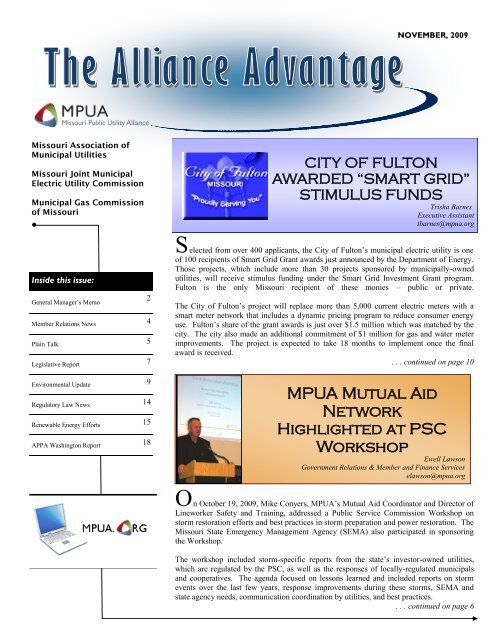

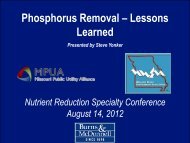

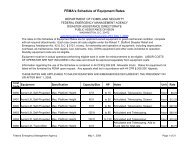
![VIA CERTIFIED MAIL (Return Receipt Requested) [DATE] Ms ...](https://img.yumpu.com/43063436/1/190x245/via-certified-mail-return-receipt-requested-date-ms-.jpg?quality=85)
